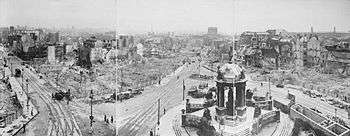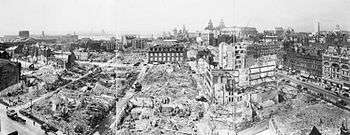Liverpool Blitz
.jpg)
The Liverpool Blitz was the heavy and sustained bombing of the British city of Liverpool and its surrounding area, during the Second World War by the German Luftwaffe.
Liverpool was the most heavily bombed area of the country, outside London,[1] due to the city having, along with Birkenhead, the largest port on the west coast and was of incalculable importance to the British war effort. The government was concerned to hide from the Germans just how much damage had been inflicted upon the docks, so reports on the bombing were kept low-key. Around 4,000 people were killed in the Merseyside area during the Blitz.[1] This death toll was second only to London, which suffered 30,000 deaths by the end of the war.
Liverpool, Bootle and the Wallasey Pool complex were strategically very important locations during the Second World War. The large port had for many years been the United Kingdom's main link with North America, and would prove to be a key part in the British participation in the Battle of the Atlantic. As well as providing anchorage for naval ships from many nations, the port's quays and dockers would handle over 90 per cent of all the war material brought into Britain from abroad with some 75 million tons passing through its 11 miles (18 km) of quays. Liverpool was the eastern end of a Transatlantic chain of supplies from North America, without which Britain could not have pursued the war.
Preparations for war
The evacuation of children (Operation Pied Piper) at the start of the war, in September 1939, was a pre-emptive measure to save the population of urban or military areas from German aerial bombing. The evacuations were organised by Liverpool Corporation and though some children were transported to smaller towns nearby, many went to rural areas in North Wales and Cheshire.
Beginning of the blitz
The first major air raid on Liverpool took place in August 1940, when 160 bombers attacked the city on the night of 28 August.
This assault continued over the next three nights, then regularly for the rest of the year. There were 50 raids on the city during this three-month period. Some of these were minor, comprising a few aircraft, and lasting a few minutes, with others comprising up to 300 aircraft and lasting over ten hours. On 18 September, 22 inmates at Walton Gaol were killed when high-explosive bombs demolished a wing of the prison.[2]
28 November saw a heavy raid on the city, and the most serious single incident, when a hit on an air-raid shelter in Durning Road caused 166 fatalities.[1] Winston Churchill described it as the "single worst incident of the war".[3]
The air assault in 1940 came to a peak with the Christmas blitz, a three-night bombardment towards the end of December.
Christmas blitz
A series of heavy raids took place in December 1940, referred to as the Christmas blitz, when 365 people were killed between 20 – 22 December.[4] The raids saw several instances of direct hits on air raid shelters; on 20 December 42 people died when a shelter was hit, while another 40 died when a bomb struck railway arches on Bentinck Street, where local people were sheltering.[4] On 21 December another hit on a shelter killed 74 people.[4]
The bombing decreased in severity after the new year.
May blitz


May 1941 saw a renewal of the air assault on the region; a seven-night bombardment that devastated the city.[5] The first bomb landed upon Seacombe, Wallasey, Wirral, at 22:15 on 1 May.[6] The peak of the bombing occurred from 1 – 7 May 1941. It involved 681 Luftwaffe bombers; 2,315 high explosive bombs and 119 other explosives such as incendiaries were dropped. The raids put 69 out of 144 cargo berths out of action and inflicted 2,895 casualties[nb 1] and left many more homeless.
Liverpool Cathedral was hit by a high explosive bomb which pierced the roof of the south-east transept before being deflected by an inner brick wall and exploding mid-air, damaging many stained glass windows. Another landed on the front steps without exploding but incendiaries destroyed equipment in the contractor's yard at the west end.[7]
One incident on 3 May involved the SS Malakand, a ship carrying munitions which was berthed in the Huskisson Dock. Although its eventual explosion is often attributed to a burning barrage balloon, this fire was put out. However flames from dock sheds that had been bombed spread to the Malakand, and this fire could not be contained. Despite valiant efforts by the fire brigade to extinguish the flames, they spread to the ship's cargo of 1,000 tons of bombs, which exploded a few hours after the raid had ended. The entire Huskisson No. 2 dock and the surrounding quays were destroyed and four people were killed. The explosion was so violent that some pieces of the ship's hull plating were blasted into a park over 1 mile (1.6 km) away. It took seventy-four hours for the fire to burn out.[8]
Bootle, to the north of the city, suffered heavy damage and loss of life.[9] Over 6,500 homes in Liverpool were completely demolished by aerial bombing and a further 190,000 damaged.
The Times on 5 May 1941, carried the following report:" The Germans stated that Saturday night's attack on Liverpool was one of the heaviest ever made by their air force on Britain. Several hundred bombers had been used, visibility was good and docks and industrial works, storehouses and business centres, had been hit. In addition to many smaller fires, one conflagration, it was claimed, was greater than any hitherto observed during a night attack."
End of the blitz
After the raids in May 1941, the German air assault diminished, as Hitler's attention turned towards attacking the Soviet Union. The last German air raid on Liverpool took place on 10 January 1942, destroying several houses on Upper Stanhope Street. By a quirk of fate one of the houses destroyed was number 102, which had been the home of Alois Hitler, Jr, half brother of Adolf Hitler and the birthplace of Hitler's nephew, William Patrick Hitler.[10] The house was never rebuilt and the whole site was eventually cleared of housing and grassed over.
By the end German bombs had killed 2,716 people in Liverpool, 442 people in Birkenhead, 409 people in Bootle and 332 people in Wallasey.[11]
Aftermath

Today one of the most vivid symbols of the Liverpool Blitz is the burnt outer shell of St Luke's Church, located in the city centre, which was destroyed by an incendiary bomb on 5 May 1941. The church was gutted during the firebombing but remained standing and, in its prominent position in the city, was a stark reminder of what Liverpool and the surrounding area had endured. It eventually became a garden of remembrance to commemorate the thousands of local men, women and children who died as a result of the bombing of their city and region. Other architectural casualties of the Blitz included the Custom House, Bluecoat Chambers, and Liverpool Museum. However, many buildings were restored after the War, while the Custom House was controversially demolished.
British Prime Minister Winston Churchill in May 1941 said after visiting Liverpool and the surrounding area, "I see the damage done by the enemy attacks, but I also see ... the spirit of an unconquered people." [12]
Notable victims
- Mary Lawson, film and stage actress[13][14]
- Francis William Lionel Collings Beaumont, heir to the Seigneur of Sark and RAF officer[13][14]
See also
References
Notes
- ↑ 1,741 people were killed and 1,154 people were injured
Citations
- 1 2 3 The Liverpool Blitz at liverpool museums.org
- ↑ Whittington-Egan, Richard (1987). The Great Liverpool Blitz. The Gallery Press, Liverpool Dossier Series. p. 34. ISBN 0-900389-27-3.
- ↑ http://www.liverpoolecho.co.uk/news/liverpool-news/70th-anniversary-durning-road-bomb-3391399 70th anniversary of Durning Road bomb disaster that claimed 166 Liverpool lives
- 1 2 3 Liverpool blitz at nwlg.org
- ↑ "Liverpool May Blitz remembered with parade and ceremony". Liverpool Echo. 2011-04-30. Retrieved 2013-08-22.
- ↑ Liverpool and the Blitz
- ↑ Whittington-Egan 1987, p. 24.
- ↑ "E. Chambré Hardman Archive". Retrieved 7 February 2012.
- ↑ The Liverpool Blitz at liverpool museums
- ↑ The Scouse Hitler at bbc.co.uk
- ↑ "E. Chambré Hardman Archive". Retrieved 7 February 2012.
- ↑ The May Blitz at liverpool museums
- 1 2 "Second Raid on Humber Area Many Casualties, Other Attacks in North Midlands". Issue 48922; col C. The Times. 10 May 1941. p. 2.
- 1 2 "Mary Lawson, British Actress, Killed in Raid". Chicago Tribune. 10 May 1941. p. 8.
External links
- History of Liverpool Blitz
- St Luke's Bombed Out Church Official Website
- Photographs
- The May Blitz on YouTube
- Liverpool Museums, further information
- BBC website with further information
- Additional information on the SS Malakand
- Timeline
- Some details of the Liverpool blitz from first hand accounts and the reason why Edge Hill was a particular target.